|
|
Snohomish County provided nearly $78,000 this past spring for community organizations with projects or events focused on addressing the drug crisis. The recovery money came from settlements of opioid lawsuits. As the second round of community funding applications – about $72,000 more – wraps up, we wanted to highlight some of the success stories from that first round.
Advocates Recovery Services Housing received $7,500 for their Recovery Coach Scholarship Fund. The funding has allowed the organization to offer Recovery Coach Certifications. They now host monthly classes with full scholarships available, enough to cover tuition and materials for at least 15 Snohomish County residents with lived experience.
“If you know someone who has interest in learning more about recovery for themselves, their work, or someone they care about, please encourage them to sign up,” Vice President Esther Riley said. “We hope to provide this to as many people as we can and would love to involve other organizations that would like to train their staff or volunteers. The skills that are learned in these classes are lifelong resources and a wonderful addition to anyone working with those suffering from substance use disorder.”
Courage to Change also received $7,500. They are using the money to help clients without funding pay for a stay at Nick’s Place, which provides low-barrier recovery housing.
“Our goal is to help those who have no other funds or options find emergency recovery housing,” said Christina with Courage to Change. “We are always accepting volunteers to help us.”
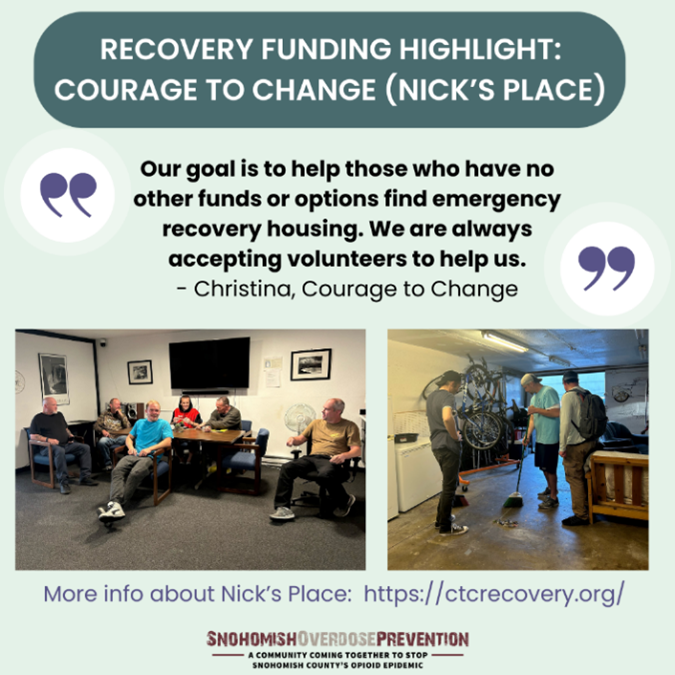 Click the image to learn more about Courage to Change.
|
|
|
Snohomish County has partnered with first responders to establish a leave-behind program that helps provide life-saving supplies in the community.
The program provides kits for responders to leave with family and friends of those who may be at risk for overdose. The kits can be given out during regular outreach activities or after an overdose response.
Each kit contains gloves, sanitizer, a CPR face shield, two doses of Narcan, and a pocket resource guide that has info on signs of overdose, how to respond, and links to treatment and support. More than 200 kits have been distributed so far this year. The program started with one partner in January and has expanded gradually throughout the year.
“Getting naloxone into the hands of everyone in our community is critical in reducing deaths from overdose,” said Dr. Ryan Keay, the medical program director for Snohomish County EMS. “The naloxone leave-behind program allows our pre-hospital providers to give naloxone liberally in the community to high-risk individuals, family members, bystanders, or anyone who asks. We are grateful to the Snohomish County Health Department for facilitating such a fantastic program."
So far, 10 partners are involved. Thank you to North County Fire & EMS, South County Fire & EMS, City of Everett’s embedded social workers, Lake Roesiger Fire, Snohomish Regional Fire & Rescue, the Medical Examiner’s Office, Everett Fire, Sheriff’s Office, Fire District No. 5 (Sultan and Startup areas), and Fire District No. 24 (Darrington).
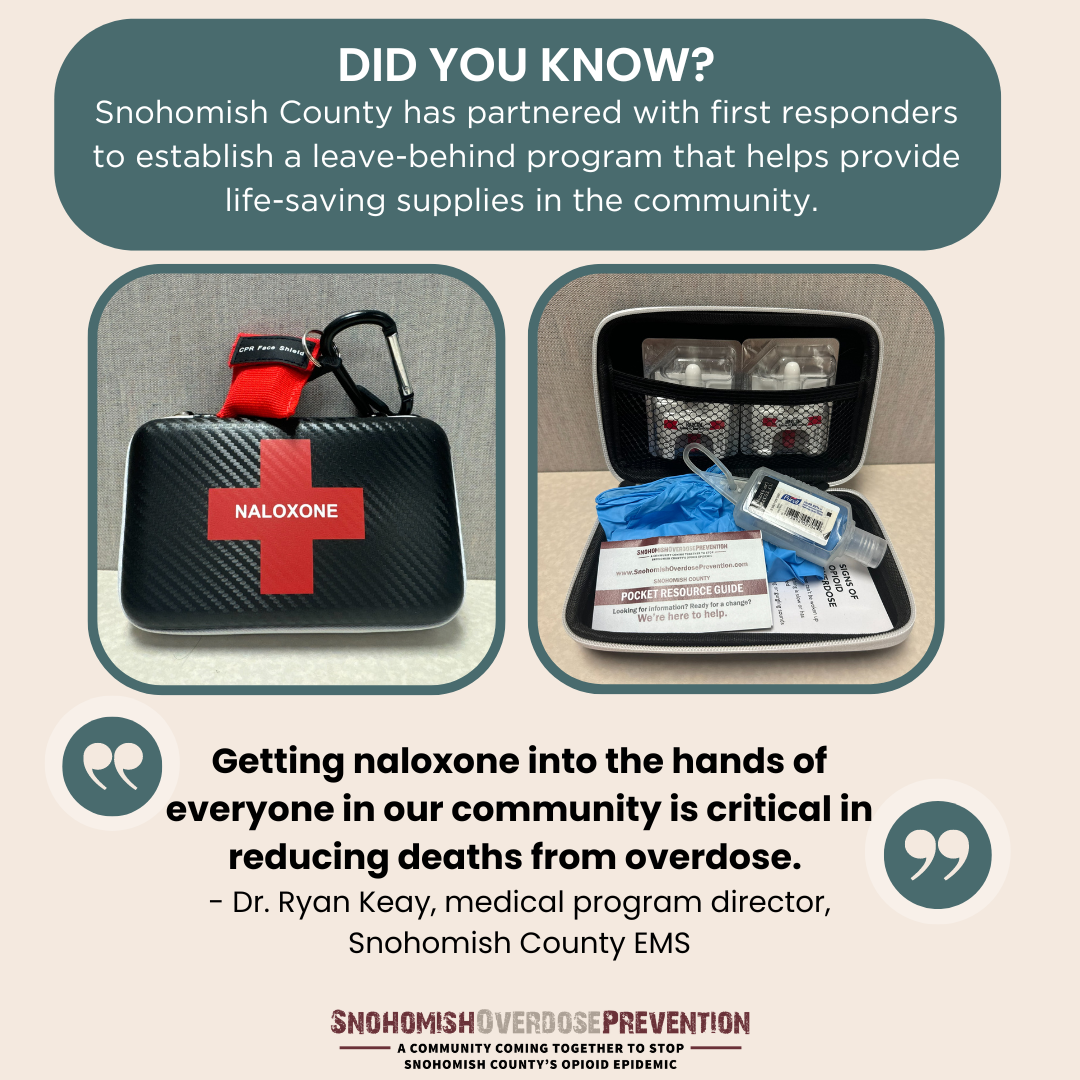 Click the image above to learn more about options for finding naloxone near you.
|
|
|
Snohomish County Proposition 1 will be on the November 5 ballot. Want to learn more about what a Public Safety Sales Tax is and what the money would be used for? Find answers to some frequently asked questions in this information sheet and online at https://bit.ly/SnoPSST
Information sheets like the one below are also available at the link.
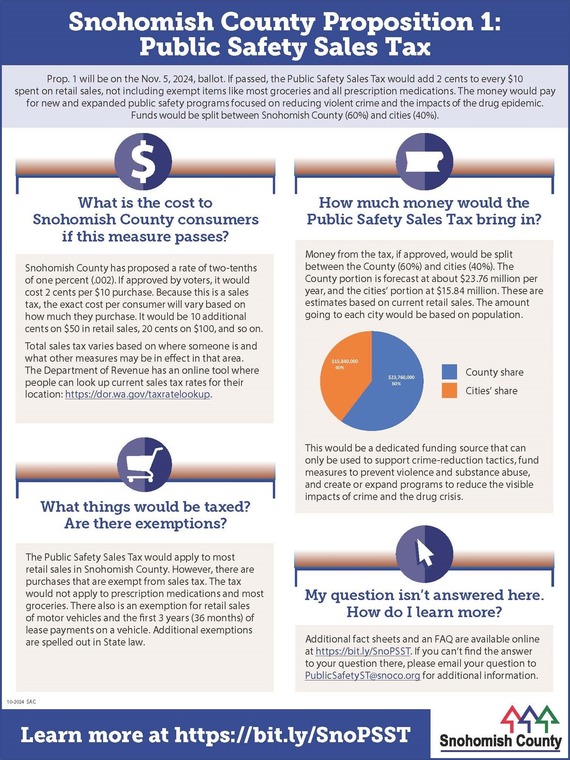 Click on the image above to view full size.
|
|
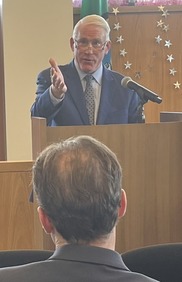
Snohomish County Adult Recovery Court on Oct. 3 celebrated 25 years of providing therapeutic and legal services for people affected by substance use disorder and involved with the criminal justice system.
Court staff, local leaders, recovery court graduates, and other guests gathered to recognize the program’s legacy of hope of recovery and to look toward the future.
“Drug courts, and therapeutic courts, are evidence-based interventions which provide an off-ramp from the legal system to effectively address behaviors that are harming our community,” said Superior Court Judge Joseph Wilson. The image at right shows the judge speaking at the celebration.
Since its inception, more than 2,000 people have participated in Adult Recovery Court, and 981 have fully completed the program.
|
“We are facing a drug epidemic, and Adult Recovery Court is a powerful tool to help us address that challenge. It changes the lives of participants, the lives of their families and loved ones, and the community,” Snohomish County Executive Dave Somers said. “Recovery Court balances accountability and compassion, and we need both if we want to make a difference in this crisis.”
“Drug court gave me the opportunity to completely change my life and allowed me to access the services to become the person I was always meant to be,” said DJ Rivera, an Adult Recovery Court graduate. “Today I am a dad, a son, a brother, an employee, a coach, and many other things that allow me to give back to my community.”
Read the full press release.
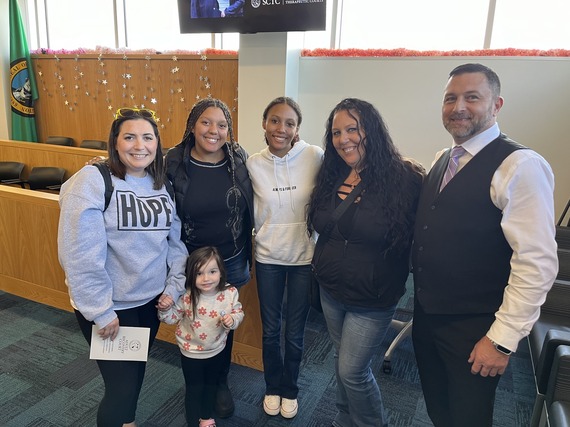 Snohomish County Adult Recovery Court graduates and loved ones.
|
|
|
U.S. Rep. Rick Larsen (D-Everett) convened an Oct. 23 gathering of leaders working to address the drug crisis in Snohomish County and summarized the takeaway from that meeting with a single word.
“Hope,” Larsen said in a post to X, the social media platform formerly known as Twitter.
The gathering brought together city, county, state and tribal leaders, as well as those working to reduce harm connected to substance use disorder and the carnage associated with illegal use of fentanyl and other substances.
Larsen has been partnering with others in Congress to craft legislation aimed at the drug crisis. This week he introduced the Closing the Substance Use Care Gap Act. The bill would provide community-based organizations with more resources to administer life-saving harm reduction programs and services to people struggling with substance use.
“The opioid crisis is devastating Northwest Washington,” Larsen said. “This bill helps close the gap between members of our community who want treatment for substance use disorder and those who actually receive it. Congress must stay focused on breaking down barriers to effective community-based solutions that meet people where they are, prevent overdoses and save lives.”
Snohomish County Executive Dave Somers praised Larsen’s efforts.
“Washington is fortunate to have Representative Larsen working at the federal level to combat the opioid epidemic and ensure federal resources are being delivered where they are most needed,” Somers said in a press release. “I support the Closing the Substance Use Care Gap Act because it is a powerful tool to help fund key components of Snohomish County’s life-saving efforts, including Medication-Assisted Treatment (MAT), overdose reversal medication, and addiction prevention.”
In September, Larsen introduced the End Fentanyl Trafficking with Local Task Forces Act to establish a dedicated federal funding stream to help multi-jurisdictional drug task forces combat opioid trafficking in Washington state and across the country.
In Washington state and around the country, law enforcement agencies have partnered across jurisdictions to form task forces that coordinate information, resources and staff to target the illegal distribution of drugs at the local and regional levels. The Snohomish Regional Drug Task Force is an example. Its executive board released a statement praising the legislation's aims.
Tulalip Tribes Chairwoman Teri Gobin offered support for the task force bill.
“The drug trafficking distribution network has expanded throughout Washington State and into our tribal communities, crossing jurisdictional boundaries and exploiting law enforcement resources and jurisdictional gaps. The Tulalip Indian Reservation is located adjacent to Interstate-5, a major thoroughfare for fentanyl and other illicit drugs. The Tulalip Police Department needs improvements to technology and sufficient resources to create a multi-jurisdictional approach to combat the opioid crisis that has had devastating effects on tribal members, their families, and many Washingtonians. The End Fentanyl Trafficking with Local Task Force Act will do just this. We urge Congress to pass this important piece of legislation.”
See this fact sheet for details on what the task force legislation would authorize, and this fact sheet for the closing the gap bill.
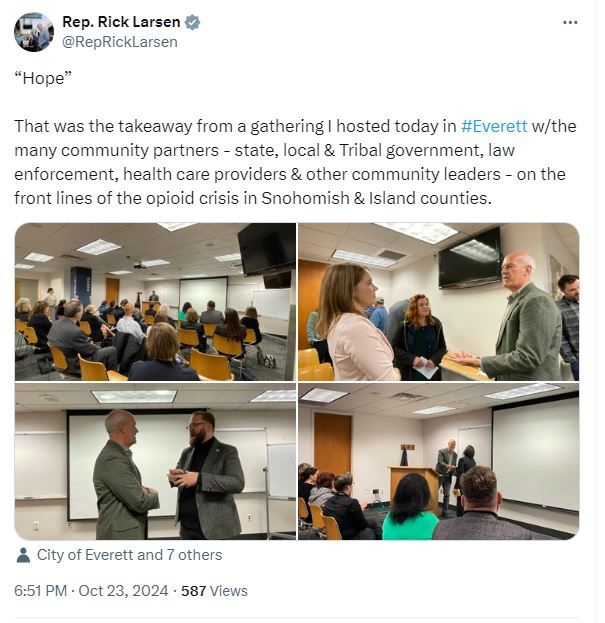 U.S. Rep. Rick Larsen X post on drug crisis meeting in Everett.
|
|
|
Emergency medical services (EMS) providers say being able to provide medication for opioid use disorder in the field is giving them hope. Snohomish County is pleased to be a partner supporting the program, which started this summer as another tool for addressing the drug crisis in our community.
"Up until recently, all our treatments for overdose, especially opioid overdose, were largely reactive. This often left our firefighters and paramedics feeling helpless and unable to offer meaningful solutions,” said Matt Hickman, a community resource paramedic. “Coordinated Overdose Response by EMS (CORE) allows us to offer those in our community suffering from opioid use disorder the emergency care we've always provided, but adds a crucial layer of support.”
Part of that support is training paramedics on buprenorphine and providing it for use in the field. Buprenorphine is a medication that can prevent withdrawal symptoms and help reduce the craving to use opioids without causing the feeling of being high. It’s been shown to greatly reduce the likelihood of someone dying due to overdose and can help facilitate long-term recovery. Paramedics with participating EMS providers can offer a dose to patients they revive after an overdose to help manage withdrawal effects and cravings, and to provide an opportunity to connect with the patient about treatment and recovery options.
“Buprenorphine is a powerful tool, coupled with a coordinated response with social work and community resource paramedics, to intervene on the symptoms of withdrawal and help a patient towards recovery,” said Dr. Ryan Keay, the medical program director for Snohomish County EMS.
And for first responders who provide emergency medical care in the field, these coordinated efforts and additional resources are bringing hope. At South County Fire, all paramedics are being training on what buprenorphine is, how to administer it, and the protocols for initiating the medication in the field.
“Paramedics who have taken the training have expressed that they feel like they have been given a solution to help break the cycle of overdose and more easily meet people where they’re at,” said Captain Nicole Picknell, community paramedic captain with South County Fire. “This is giving paramedics a feeling of hope for the first time ever with the overdose crisis.”
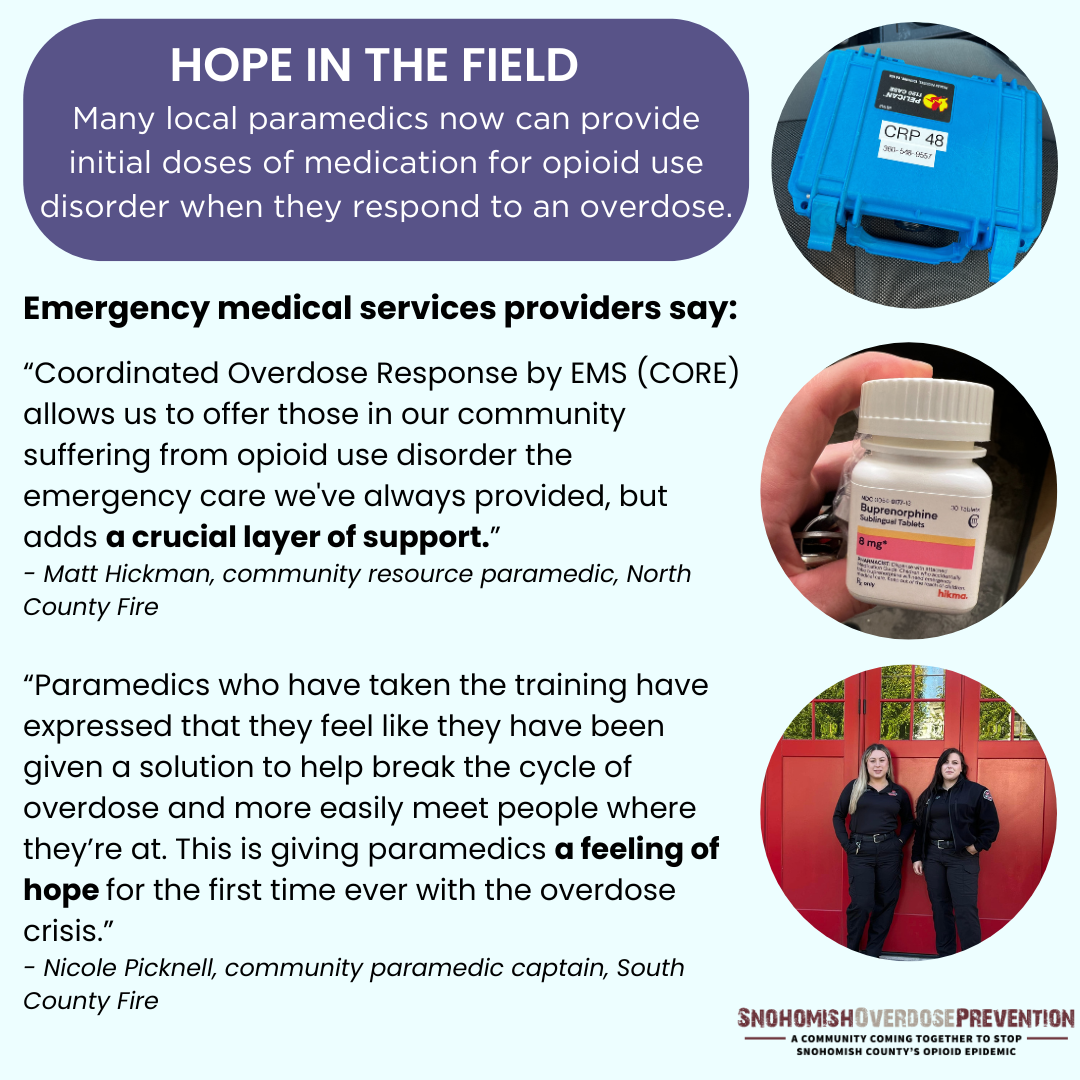 Click the image above to learn more about medication-assisted treatment options..
|
|

The Centers for Disease Control and Prevention (CDC) on Oct. 2 warned about a potential public health risk among individuals ordering what they believe to be prescription medications from online pharmacies. On September 30, 2024, the U.S. Department of Justice (DOJ) announced an indictment against individuals allegedly running illegal online pharmacies. According to the DOJ, the investigation found people advertising, selling, manufacturing, and shipping millions of unregulated counterfeit prescription pills to tens of thousands of individuals in the U.S. The pills frequently contained fentanyl and methamphetamine, placing people who ordered drugs from these illegal pharmacies at risk for an overdose, the CDC warned.
The U.S. Food and Drug Administration warns that there are online pharmacies that claim to sell prescription drugs at deeply discounted prices, often without requiring a prescription. These internet-based pharmacies often sell unapproved, counterfeit, or otherwise unsafe medicines outside the safeguards followed by licensed pharmacies. Individuals should only take medications prescribed by a licensed healthcare provider and dispensed by a licensed pharmacy.
The Safe Pharmacy website operated by the National Association of Boards of Pharmacy offers resources to help you safely access and handle medications.
Read the full CDC statement.
|
|
|
|
|
|